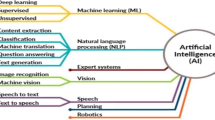Abstract
We present a framework for constructing representations of space in an autonomous agent which does not obtain any direct information about its location. Instead the algorithm relies exclusively on inputs from its sensors. Activations within a neural network are propagated in time depending on the input from receptors which signal the agent's own actions. The connections of the network to receptors for external stimuli are adapted according to a Hebbian learning rule derived from the prediction error on sensory inputs one time step ahead. During exploration of the environment the respective cells become selectively activated by particular locations and directions even when relying on highly ambiguous stimuli.
Similar content being viewed by others
References
Abeles, M. 1991. Corticonics: Neuronal Circuits of the Cerebral Cortex, Cambridge University Press.
Braitenberg, V. 1986. Vehicles: Experiments in Synthetic Psychology, MIT Press: Cambridge, MA.
Duckett, T. and Nehmzow, U. 1997. Knowing your place in the real world. ECAL-97 Fourth European Conference on Artificial Life, University of Sussex, http://www.cogs.susx.ac.uk/ecal97/.
Franz, M.O. and Mallot, H.A. 1998. Biomimetic robot navigation. Technical report, no. 65, MPI für biologische Kybernetik, Tübingen. http://www.kyb.tuebingen.mpg.de/bu.html.
Herrmann, M., Hertz, J.A., and Prügel-Bennett, A. 1995. Analysis of synfire chains. Network: Computation in Neural Systems, 6:403-414.
Herrmann, M., Pawelzik, K., and Geisel, T. 1998. Self-localization by hidden representations. In ICANN'98, Proc. of the 8th Int. Conf. on Artificial Neural Networks, Skövde, Sweden, 2–4 Sept. 1998, L. Niklasson, M. Bodén, and T. Ziemke (Eds.), Springer: London, pp. 1103-1108.
Herrmann, M., Pawelzik, K., and Geisel, T. 1998. Simultaneous self-organization of place and direction selectivity in a neural model of self-localization (abstract). Computation and Neural Systems meeting (CNS * 98), Santa Barbara, California, July 26–30, 1998.
Hertz, J.A. and Prügel-Bennett, A. 1996. Learning synfire chains: turning noise into signal. Int. J. Neural Systems, 7:445-450.
Kaelbling, L.P., Cassandra, A.R., and Kurien, J.A. 1996. Acting under uncertainty: Discrete bayesian models for mobile-robot navigation. In Proceedings of IEEE/RSJ International Conference on Intelligent Robots and Systems.
Mallot, H., Bülthoff, H., Georg, P., Schölkopf, B., and Yasuhara, K. 1995. View-based cognitive map learning by an autonomous robot. Proc. ICANN'95, EC2 & Cie, Paris, Vol. 2, pp. 381-386.
Michel, O. 1996. Khepera Simulator version 2.0: Freeware mobile robot simulator, University of Nice Sophia-Antipolis. Downloadable at http://wwwi3s.unice.fr/~om/khep-sim.html.
Muller, R. 1996. A quarter of a century of place cells. Neuron, 1:813-822.
O'Keefe, J. and Dostrovsky, J. 1971. The hippocampus as a spatial map: preliminary evidence from unit activity in the freely-moving rat. Brain Res., 34:171-175.
Oore, S., Hinton, G.E., and Dudek, G. 1997. A mobile robot that learns its place. Neur. Comp., 9:683-699.
Quirk, G.J., Muller, R.U., and Kubie, J.L. 1990. The firing of hippocampal place cells in the dark depends on the rat's recent experience. Jour. Neurosci., 10(6):2008-2017.
Rabiner, L.R. 1989. A tutorial on hidden markov models and selected applications in speech recognition. Proc. IEEE, 77:257-286.
Salinas, E. and Abbott, L.F. 1996. A model of multiplicative neural responses in parietal cortex. Proc. Natl. Acad. Sci.USA, 93:11956-11961.
Samsonovich, A. and McNaughton, B.L. 1997. Path integration and cognitive mapping in a continuous attractor neural network model. J. Neuroscience, 17:5900-5920.
Shatkay, H. and Kaelbling, L.P. 1997. Learning topological maps with weak local odometric information. In Proceedings of the Fifteenth International Joint Conference on Artificial Intelligence.
Skaggs, W.E., Knierim, J.J., Kudrimoti, H.S., and McNaughton, B.L. 1994. A model of the neural basis of the rat's sense of direction. In Advances in Neural Information Processing Systems, G. Tesauro, D. Touretzky, and T. Leen (Eds.), Morgan Kaufmann, Vol. 7, pp. 173-182.
Taube, J.S., Muller, R.U., and Ranck Jr., J.B. 1990a. Head-direction cells recorded from the postsubiculum in freely moving rats. I. Description and quantitative analysis. Jour. Neurosci., 10:420-435.
Taube, J.S., Muller, R.U., and Ranck Jr., J.B. 1990b. Head-direction cells recorded from the postsubiculum in freely moving rats. II. Effects of environmental manipulations. Jour. Neurosci., 10:436-447.
Thrun, S. 1997. Learning metric-topological maps for indoor mobile robot navigation. Artificial Intelligence, 99:21-71.
Touretzky, D.S., Wan, H.S., and Redish, A.D. 1994. Neural representation of space in rats and robots. In Computational Intelligence: Imitating Life, J.M. Zurada and R.J. Marks (Eds.), IEEE Press: Piscataway, NJ.
Wilson, M.A. and McNaughton, B.L. 1993. Evolution and dynamics of the hippocampal ensemble code for space in a novel environment. Science, 261:1055-1058.
Yamauchi, B., Schultz, A., and Adams, W. 1998. Mobile robot exploration and map-building with continuous localization. Proc. 1998 IEEE Conf. on Robotics and Automation, Leuven, Belgium, pp. 3715-3720.
Zhang, K., Ginzburg, I., McNaughton, B.L., and Sejnowski, T.J. 1998. Interpreting neuronal population activity by reconstruction: A unified framework with application to hippocampal place cells. Jour. Neurophys., 79:1017-1044.
Author information
Authors and Affiliations
Rights and permissions
About this article
Cite this article
Herrmann, J.M., Pawelzik, K. & Geisel, T. Self-Localization of Autonomous Robots by Hidden Representations. Autonomous Robots 7, 31–40 (1999). https://doi.org/10.1023/A:1008913712526
Issue Date:
DOI: https://doi.org/10.1023/A:1008913712526




